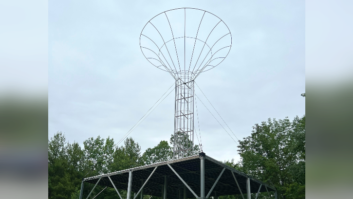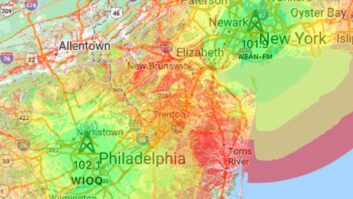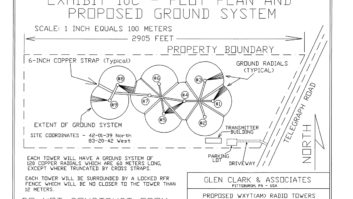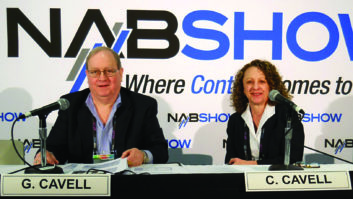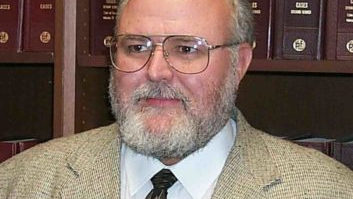IBOC antennas
Nov 1, 2003 12:00 PM, By John Battison, P.E., technical editor, RF
Despite the hiatus in nighttime operation for AM IBOC, antenna research is continuing in an effort to comply with the FCC’s existing requirements of two antennas for FM IBOC, and develop a system using one antenna that will satisfy the FCC’s requirements.
The AM situation is still fluid while daytime operation is being practiced by a number of stations with varying reports of its success. Nighttime AM IBOC operation and the effect of skywave are still being examined. It appears that the most difficult problem to solve is the adjacent-channel situation, which is reported to cause considerable interference and signal degradation from daytime IBOC. Some engineers have reported that even strong, desired signals are being affected by adjacent channel hiss with subsequent listener loss.
In the FM field, an FCC decision determining the number and form of antennas allowed is still pending. The ultimate transmitting antenna configuration has a great deal to do with the type of transmitter installation and transmitter design, and has considerable impact on transmitter and installation cost. At first glance, it appears that a radiator for analog and digital signals would be the best because it should be the most cost-effective approach. However, the various combinations of combiner, isolator and antenna can add considerably to the cost of an installation.

Figure 1. A simple coaxial RF signal combiner.
The type of antenna selected is governed greatly by budgetary considerations as well as the number of stations feeding signals into the antenna. The panel-type antenna is possibly the most easily adapted antenna, but the decision to use it is governed by the number of stations involved. Interleaved standard radiators offer a cost-efficient alternative, provided that sufficient isolation between the analog and digital antennas can be achieved.
The commission is expected eventually to allow the use of separate antennas for analog and digital signals. This will probably make it convenient to use a station’s auxiliary antenna for the digital signal, provided that it is no higher than the main antenna, within a specified distance and sufficient isolation can be achieved. There is one caveat that must be remembered and followed � control of non-ionizing radiation.
When the original installation was designed, the environmental radiation values were calculated using the main antenna field to check for clearance, and the operation of both antennas at the same time was not envisioned. The addition of �X� kilowatts from the close-by auxiliary antenna may cause the RF field to exceed the safe limits for the various EPA RF levels.
As usual, the level of RF power has a tremendous impact on the cost of equipment. A circulator is essential when using separate antennas because there is usually an isolation of about 20dB. An isolator for a 500W-or-less digital transmitter costs around $4,000. However, an isolator for a 1kW transmitter would be about $13,000. Isolation is critical when using two antennas and anything less than a 20dB rejection can allow too much signal to feed back into the system with considerable effect on the isolator/combiner design and costs in addition to wasting signal power.
Variations on a theme
Figure 1 illustrates a coaxial RF signal combiner that consists of a cavity illuminated by two signals with different polarizations. One is the analog signal and the other is the digital signal. Mounted at the far end of the cavity is a circularly polarized receiving device that intercepts both signals and combines them into a single output.
Figure 2 shows a single antenna with combiner circuitry. Figure 3 shows an interleaved antenna. The separate transmission lines are shown together with the isolator. This is an acceptable way of converting to FM IBOC. Maybe the Commission’s original objections to separate antennas was the consideration that one signal might enjoy better propagation conditions than the other and result in improper IBOC operation.

Figure 2. A typical single antenna with combiner circuitry.
Interleaving standard FM antenna bays is a simple operation, and by adjusting the radiator location on the tower, identical centers of antenna radiation above average terrain can be achieved, thus producing effectively equal signal in most locations.
Put into practice
At the heart of Entercom’s operation is the 200 ft. tower located 3,000 ft. above sea level on West Tiger Mountain near Seattle. Ten FM stations originate from this site. Their frequencies cover the entire FM band through a combination of Shively model 6810 antennas, ERI cavity-backed panel antennas and a pair of rototiller antennas.
For its IBOC tests, Clay Freinwald of Entercom uses the four-bay ERI antenna for the analog transmitter, and the two-bay rototiller auxiliary antenna for the digital signal. The vertical spacing between the antennas is between 15 ft. and 20 ft. There aren’t problems from excessive power feedback through the isolator, although as power is increased it is possible that power feedback problems may be encountered. The ERI panel antennas have three input connectors. In preparation for further work on converting to IBOC, ERI added a fourth input connection to allow an additional digital input.

Figure 3. A typical interleaved FM antenna.
So far engineering evidence supports the use of a single antenna or a combination of two radiators for the transmission of IBOC signals. By the addition of more bays and rearranging the existing antenna so that interleaving is satisfactory, the antenna system costs can be kept to a reasonable level no matter whether one or two antennas are used.
E-mail Battison at[email protected].
